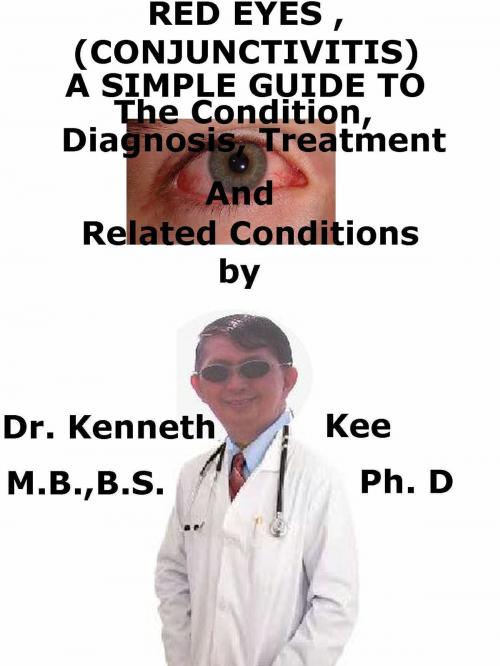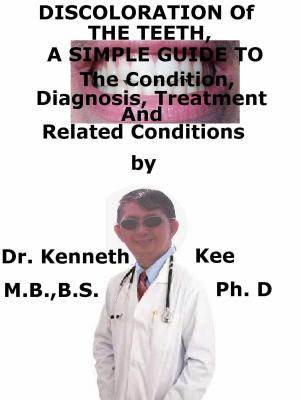Red Eyes (Conjunctivitis), A Simple Guide To The Condition, Diagnosis, Treatment And Related Conditions
Nonfiction, Health & Well Being, Health, Ailments & Diseases, Vision, Medical, Specialties, Ophthalmology| Author: | Kenneth Kee | ISBN: | 9781370216024 |
| Publisher: | Kenneth Kee | Publication: | October 3, 2016 |
| Imprint: | Smashwords Edition | Language: | English |
| Author: | Kenneth Kee |
| ISBN: | 9781370216024 |
| Publisher: | Kenneth Kee |
| Publication: | October 3, 2016 |
| Imprint: | Smashwords Edition |
| Language: | English |
Red Eyes (Conjunctivitis) is a medical disorder that produces inflammation of the conjunctiva (the white of the eye and inner lining of eyelids).
It is one of the most frequent and treatable eye infections in children and adults.
Eye redness is most often the result of swollen or dilated blood vessels.
This causes the surface of the eye look red or bloodshot.
There are many reasons of a red eye or eyes.
Some (such as glaucoma) are medical emergencies and some are a cause for worry, but not an emergency.
Causes:
1. Infectious
a. Bacteria
b. Viruses
2. Noninfectious.
a. Allergic conjunctivitis (caused by an allergic reaction)
b. Irritant conjunctivitis (caused by anything that irritates the eyes), such as irritating substances (shampoos, dirt, haze particles, smoke, and particularly pool chlorine).
Treatment is by:
1. Protect the eyes from dirt and other irritating substances.
2. Do not use contact lenses, if the patient wears them.
3. Place cold compresses on the eyes.
4. Wash the face and eyelids with mild soap or baby shampoo and rinse with water to remove irritating substances.
5. Do not rub the eyes with hands that are not washed.
6. Do not use the same bottle of drops in the other eye if it is not infected.
Bacterial conjunctivitis is normally treated with prescription antibiotic drops or ointment.
In March this year, my second grand-daughter was helping her friend in school to apply some eye drops for her mild conjunctivitis.
After school she came as usual to my house to play with her cousin (9 months old baby from my second daughter).
She later in the afternoon felt uncomfortable in the eyes and asked me to take a look at her eyes to see whether she had conjunctivitis.
She did have dilated blood vessels in the conjunctiva or the white of the eyes on both sides.
I gave her some eye drops to apply to her eyes and to rest her eyes.
The next day she woke up with painful eyes and yellow discharge.
The redness of her eyes was getting worse.
Her school friend with the “mild” conjunctivitis did not go to school because her eyes were getting worse and after seeing her eye specialist was told that she had severe adenovirus infection.
She was told to rest at home and applied more eye drops.
My grand daughter was also getting worse with painful sticky eyes and blurred vision.
As my eyes too were feeling uncomfortable and red, I told her mother (my eldest daughter) to bring her to see an eye specialist.
The eye specialist found some mucopurulent filaments stuck to her cornea which was giving her pain and removed them after applying some anesthetic eye drops.
This was not the end of the story.
The cousin (8 month old baby) then had conjunctivitis, followed by my eldest daughter and then my eldest grand daughter.
After that my wife had the conjunctivitis, followed by my second daughter (the baby’s mother) and her husband.
Each of us took about 1 week to recover from the conjunctivitis.
All the eye specialists that we consulted suspected the cause was a fast spreading aggressive adenovirus which was particularly hard to treat and took a week or more to resolve.
Luckily none of us had any severe complications or residual blurring of vision.
TABLE OF CONTENT
Introduction
Chapter 1 Red Eyes (Conjunctivitis)
Chapter 2 Cause
Chapter 3 Symptoms
Chapter 4 Diagnosis
Chapter 5 Treatment
Chapter 6 Prognosis
Chapter 7 Subconjunctival Hemorrhage
Chapter 8 Blepharitis
Epilogue
Red Eyes (Conjunctivitis) is a medical disorder that produces inflammation of the conjunctiva (the white of the eye and inner lining of eyelids).
It is one of the most frequent and treatable eye infections in children and adults.
Eye redness is most often the result of swollen or dilated blood vessels.
This causes the surface of the eye look red or bloodshot.
There are many reasons of a red eye or eyes.
Some (such as glaucoma) are medical emergencies and some are a cause for worry, but not an emergency.
Causes:
1. Infectious
a. Bacteria
b. Viruses
2. Noninfectious.
a. Allergic conjunctivitis (caused by an allergic reaction)
b. Irritant conjunctivitis (caused by anything that irritates the eyes), such as irritating substances (shampoos, dirt, haze particles, smoke, and particularly pool chlorine).
Treatment is by:
1. Protect the eyes from dirt and other irritating substances.
2. Do not use contact lenses, if the patient wears them.
3. Place cold compresses on the eyes.
4. Wash the face and eyelids with mild soap or baby shampoo and rinse with water to remove irritating substances.
5. Do not rub the eyes with hands that are not washed.
6. Do not use the same bottle of drops in the other eye if it is not infected.
Bacterial conjunctivitis is normally treated with prescription antibiotic drops or ointment.
In March this year, my second grand-daughter was helping her friend in school to apply some eye drops for her mild conjunctivitis.
After school she came as usual to my house to play with her cousin (9 months old baby from my second daughter).
She later in the afternoon felt uncomfortable in the eyes and asked me to take a look at her eyes to see whether she had conjunctivitis.
She did have dilated blood vessels in the conjunctiva or the white of the eyes on both sides.
I gave her some eye drops to apply to her eyes and to rest her eyes.
The next day she woke up with painful eyes and yellow discharge.
The redness of her eyes was getting worse.
Her school friend with the “mild” conjunctivitis did not go to school because her eyes were getting worse and after seeing her eye specialist was told that she had severe adenovirus infection.
She was told to rest at home and applied more eye drops.
My grand daughter was also getting worse with painful sticky eyes and blurred vision.
As my eyes too were feeling uncomfortable and red, I told her mother (my eldest daughter) to bring her to see an eye specialist.
The eye specialist found some mucopurulent filaments stuck to her cornea which was giving her pain and removed them after applying some anesthetic eye drops.
This was not the end of the story.
The cousin (8 month old baby) then had conjunctivitis, followed by my eldest daughter and then my eldest grand daughter.
After that my wife had the conjunctivitis, followed by my second daughter (the baby’s mother) and her husband.
Each of us took about 1 week to recover from the conjunctivitis.
All the eye specialists that we consulted suspected the cause was a fast spreading aggressive adenovirus which was particularly hard to treat and took a week or more to resolve.
Luckily none of us had any severe complications or residual blurring of vision.
TABLE OF CONTENT
Introduction
Chapter 1 Red Eyes (Conjunctivitis)
Chapter 2 Cause
Chapter 3 Symptoms
Chapter 4 Diagnosis
Chapter 5 Treatment
Chapter 6 Prognosis
Chapter 7 Subconjunctival Hemorrhage
Chapter 8 Blepharitis
Epilogue















